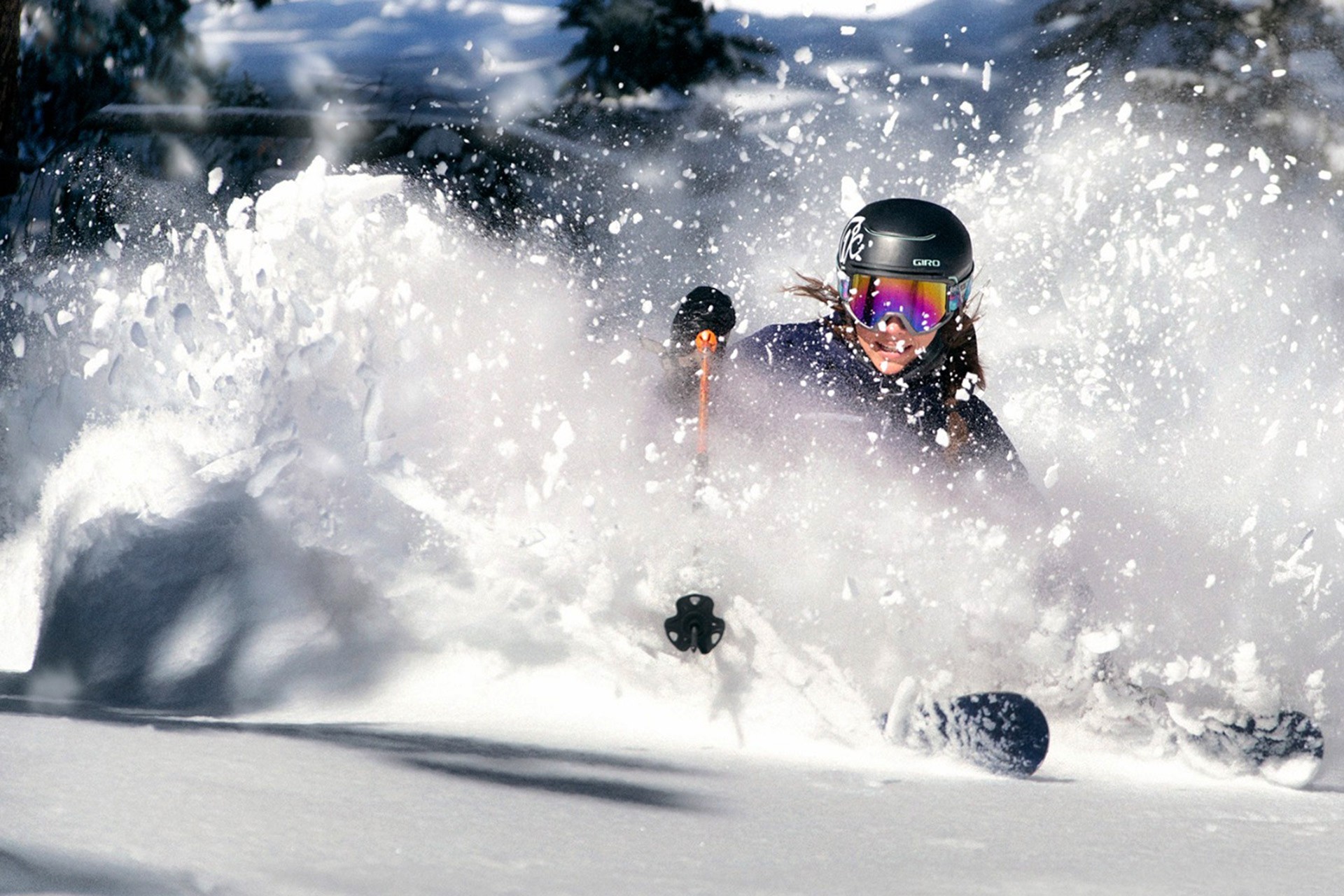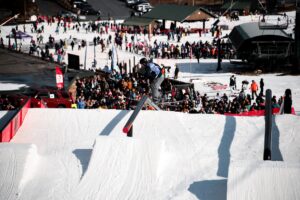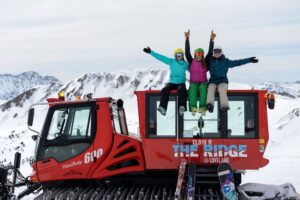You watch it move from the upper left corner of the weather map—that beautiful blue magenta blob—and your pulse elevates. Cancel that dentist appointment, reschedule that morning meeting, because snow is in the forecast and you’re going to ski or ride it.
If you can click your way around some weather sites, hop in the car with a day’s notice and drive to the best snow, you may be an amateur powder chaser. There are some people, however, who are already skiing or riding that powder before you even finish your latte. During those hours you binged-watched Netflix, they will have tracked the storm that will deliver the deepest snow total at the ski resort with the perfect steep pitch and high probability of opening the best terrain—and they will be first in line because they got there at 5 a.m. thanks to an addiction to high-quality snow and flexible jobs that allow them to leave at a moment’s notice.
Forget the Beach, Snorkels are for Snow
Luke Stone is a powder chaser who “only ride[s] when it snows,” not being tempted to get out of bed this season, for example, for anything less than 10” overnight.
“I think I’m at 26 so far this season, and the average is probably 30+. So I don’t wind up riding an insane amount of days, but then again, I do have a full-time job!” At 34 years old, the Utah resident manages pediatric oncology research trials for the University of Utah, however, his flexible schedule means he can request time off with only a day’s notice.
If he wants to ride locally, he can hit the mountain in the morning and work a half-day or later shift. “A lot of my work doing clinical research involves tasks that I can do at my desk, any time.
Certainly, there are times when I have meetings and study visits that I can’t get out of, but for the most part, my schedule is flexible and I use all of my paid time off during the winter chasing powder,” says Stone. He describes an excursion chasing the infamous bomb cyclone storm.
“Arizona Snowbowl (12” overnight, 18” storm total) north of Flagstaff, and then over to Taos (14” overnight, 33” total, and closed all day the day before) in New Mexico. I mentioned that I was thinking about taking Wed/Thu off to my boss on Monday, and then put in the official request on Tuesday. I left Salt Lake City at 4 p.m. and drove to Flagstaff, arriving around 11 p.m. Got to he mountain around 7 a.m., rode til around noon. Then I drove to Santa Fe, got dinner, went to bed. Woke up at 5 a.m. and drove two hours to Taos. Was on the mountain until 2 p.m. and then drove 10+ hours home to be at work on Friday!”
Stone also works for Powderchasers.com, a website dedicated to posting forecasts for deep snow, where he manages social media and also helps with forecasts. But his greatest passion is chasing storms and traveling to find and ride the best powder.
“At Powderchasers, we honed our skills when it comes to nailing down all aspects of a storm, including quality as well as winds during the snowfall,” he adds. Stone and his powder chasing cohorts consider themselves amateur meteorologists, specializing in predicting and hunting down the best snow. “My bookmarks are like a goldmine,” says Stone.
He uses a handful of websites, including WeatherBELL.com, Weathernerds.org, and the University of Utah’s atmospheric science page. He also looks at data from SNOTEL (snowpack sensors operated by the Natural Resources Conservation Service, or NRCS) across the country. “SNOTELs are crucial in terms of snow water content, wind speed and direction to figure out what the snow is going to be like when you get there,” says Stone. “They’re hard to find and it took a long time to collect them.”

The goal for Stone is not just figuring out where the deepest snow will be, but how to get the best bang for his buck. There are several other factors he considers, including the quality of the snow, a certain length, and steepness of the terrain, how likely it is the avalanche danger will be too high to open that terrain, and if the access road is likely to close.
“There’s a limited number of resorts that fall into that category, so we constantly look at these resorts to see if they’re going to get a big storm,” says Stone.
Snowbird, Utah is one of Stone’s favorites, but his shortlist also includes Crystal in Washington, Squaw Valley in California, Arizona Snowbowl, Big Sky in Montana, Jackson Hole in Wyoming, Telluride, Vail, and Aspen Highlands in Colorado. He’s a regular on Priceline and Expedia for low-price, day-of hotel rates, and he’ll hop on a last-minute flight to California or even New England if the conditions are right.
“I tend to only make those trips if I’m going to get two days of riding due to the cost/benefit ratio,” he says. At Mammoth, for example, Stone will take a hard look at snow quality and weather. His favorite terrain is at the summit, which often gets hit by winds, thus delaying the terrain’s opening after a storm. “If you wait 24 hours after the snow settles, it doesn’t ride as lightly,” says Stone.

Powder chasing pro
For meteorologist Chris Tomer, the perfect storm comes in on a Northwest flow pattern and favors Colorado’s Central and Northern Mountains, including Vail, Breckenridge, Steamboat, Loveland, Arapahoe Basin, and Winter Park. “A dip in the jet stream delivers the right wind direction and cold temperatures resulting in dry, light snowfall.” This fluffy, dry snow and its effects are also known as pow-pow, blower, cold smoke, white room to name a few, and even garnered a trademark from Steamboat in the form of Champagne Powder.
Tomer has an extensive background both in analyzing mountain weather and in mountaineering, including a BS in Meteorology and a decade of working with skiing and mountaineering teams from Mount Everest to Denali (you can view his weekly Snow Before You Go forecasts here at OnTheSnow).
According to Tomer, with an overwhelming amount of information, the Internet has made it possible to “wire and fire,” but he does caution amateur meteorologists: “I believe the best risk management comes from working with a professional meteorologist,” says Tomer. “You have to accept that anything less is not seeing all the weather variables at play. You don’t know what you don’t know.”
Tomer recommends developing a decision tree to evaluate the choices—and their consequences. “Once you become intimately aware of resort operations, you can tailor your decisions and then plan your drive or flight right down to the latest Google traffic report,” he says, suggesting that storm chasers in training focus on familiar ski resorts.
- In your decision tree, the canopy kicks off with the following reports from bona fide meteorologists while also looking at trends and the movement of weather systems like El Niño/La Niña. “This starts before ski season begins with medium-range and long-range forecasts,” advises Tomer.
- The middle part of the decision tree includes looking at weather patterns a week ahead for storm systems. “This consists of a mix of OnTheSnow, National Weather Service, model charts, meteorologists on social media and television, local boutique sites, local avalanche experts and forecast discussions both by professionals and locals,” says Tomer.
- The bottom of the tree is what Tomer calls “fine-tuning,” where your local knowledge comes into play, and skiers can look at risk factors as well as timing. “Having intimate understanding of specific ski area operations can make or break an experience,” Tomer points out. “For example, at what wind speed does Mammoth Mountain close lifts? Does Winter Park open certain lifts earlier for early birds? Your final decision is based on all of these factors.”
You may only have time to follow Chris Tomer’s forecasts and powder recommendations—and most certainly, that will lead to a great day on the slopes. A little extra time online and some local knowledge may lead to an epic day. Some people, like Luke Stone, have the freedom to live the ski/board bum life, though one could argue that Stone and other powder chasers like him have a lifestyle that borders on obsession.
“If you get to be the first one down the trail on a super deep day on steep terrain, it’s an incredible rush,” says Stone. “We all have addictions, ours is definitely deep storms and the feeling you get when you’re the first one down because everything lined up perfectly.”





